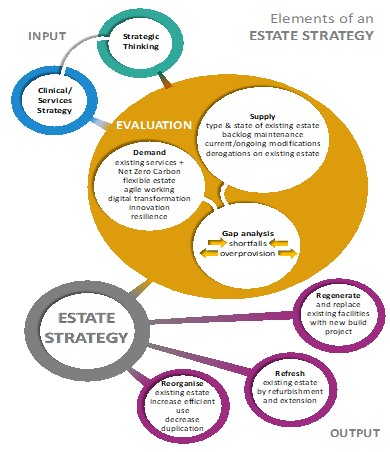Unlocking capital to invest in healthcare’s physical environment has never been more important, yet many NHS trusts fail to develop an effective estate strategy, which is essential to access funding, argues Melanie Relf, associate in healthcare strategy and planning at ETL
As we witness an extraordinary time in the history of the NHS, the service continues to grapple with its biggest challenge to date, namely the impact of COVID-19.
This, combined with the fact that investment in the NHS was at an all-time low prior to 2020, resulted in an extensive backlog of maintenance and development, plus grossly under-funded national healthcare building standards.
Today, we are also in the early stages of the biggest building programme of new hospitals for a generation, so why do so few trusts have an estate strategy in place?
Estates strategies are frequently overlooked and may now be the key to launching a successful bid for funding.
It’s therefore vital that trusts take a closer look.
These uncelebrated documents have recently taken a larger role on the healthcare stage, because of the Government’s New Hospital Programme.
Where previously considered optional, they now play a critical role in securing a much-coveted place on the ‘Go’ list.
The 2005 NHS Estates document, Developing an Estate Strategy states: “All NHS trusts, including primary care trusts (PCTs) and foundation trusts, are advised to have an estate strategy.”
Today, we are also in the early stages of the biggest building programme of new hospitals for a generation, so why do so few trusts have an estate strategy in place?
However, it is important to note that it was not obligatory, despite also being described as ‘an essential precursor to the allocation of capital’.
An estate strategy is the first step towards producing a strategic outline case, or outline business case, for any investment scheme.
Despite the ambiguity of the document’s status, there are recent examples of schemes being rejected from the New Hospital Programme due to a lack of an estate strategy.
Developing an estates strategy
Investing time and resource into developing an estate strategy is imperative.

This graphic shows some of the key elements of an effective estates strategy
And it is important to remember that an estate strategy contains several key elements. These include: a description of all the accommodation and buildings owned by a trust, accompanied by a review of the activities the trust undertakes in those buildings and whether the amount and quality of the accommodation suits the trust’s existing requirements, as well as its future plans.
This then enables a conclusion to be drawn as to:
- Whether the accommodation can be reallocated more efficiently
- Whether services are unnecessarily duplicated
- Where there are gaps in the service
At ETL we often see examples where the clinical or services strategy is used as a base document to extract pertinent information to create the estate strategy.
Despite the ambiguity of the document’s status, there are recent examples of schemes being rejected from the New Hospital Programme due to a lack of an estate strategy
If the clinical strategy is not current, the trust may find itself in a challenging situation.
But, in this situation, hope is not lost as while the clinical strategy may be outdated, strategic thinking by healthcare planning experts can overcome this using clinical evidence and best practice to make logical deductions, without waiting for capacity projections.
In addition to the baseline information required within the estate strategy, the opportunity exists to incorporate several other aspects to ensure a trust’s accommodation will meet its requirements beyond the next 10 years. These include:
- Flexible estate
- Agile working
- Resilience
- Sustainability and net zero carbon
- Digital transformation
- Modern methods of construction (MMC)
- Derogations
- Innovation
Net zero carbon in strategic estate planning
A paradigm shift is taking place in the NHS, transitioning estate planning priorities towards delivering upon sustainability objectives.
Since the publication of the NHS Operational Planning and Contracting Guidance in January 2020, the NHS requires all new buildings and refurbishments to meet net zero carbon standards, and business cases must include net zero ambitions and planning or risk push back from NHSE/I.
paradigm shift is taking place in the NHS, transitioning estate planning priorities towards delivering upon sustainability objectives
NHS-specific guidance for delivering net zero in spring 2021, provided much-needed details and information for integrating net zero principles into the estate.
And there is much that can be done now to prepare for net zero carbon, including identification of significant opportunities for decarbonisation and rationalisation of buildings and space.
Key opportunities for NHS sites, in particular, include:
- Shifting from steam systems to low-temperature hot water to enable heat pump technology
- Reducing office space in favour of agile working
- LED lighting upgrade opportunities
- Ensuring contracted partners are also committed to net zero through tendering processes
- Consideration of energy and resource requirements from clinical interventions, such as MRI scanners
- Enabling access to public transportation and integrating electric vehicle charging infrastructure
Planning for net zero as part of the estate strategy is critical, and must be anticipated, designed, and costed in at the earliest stages of estate and project planning.
ETL is supporting several NHS clients to prepare for net zero and has developed design briefs key interventions required aligned to each RIBA stage to support delivery of net zero.
As we move through 2021 the NHS will face some of its toughest challenges and strategic estate planning is essential in the wake of Coronavirus, as well as securing all-important capital funding to ensure a fit-for-purpose healthcare service for generations to come.
